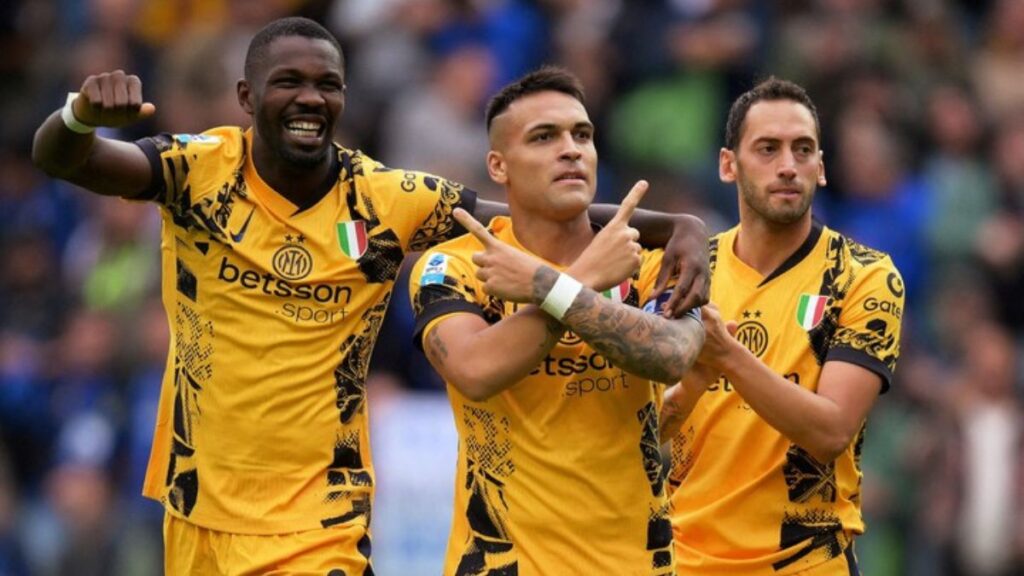Act I: More Than a Match
When you hear Inter vs. Estrella Roja, what comes to mind? A group-stage European clash? A low-key skirmish between old giants and upstart challengers? Think again.
This isn’t just about a 90-minute ballet of boots and tactics. It’s about legacy vs. resurgence. Glamour vs. grit. Milanese polish vs. Balkan steel. When Inter Milan and Red Star Belgrade meet, the floodlights cast more than shadows—they light up decades of history, trauma, triumph, and transformation.
Let’s peel back the layers.
Act II: Who’s Who – Inter Milan, La Beneamata
FC Internazionale Milano, or Inter Milan, need no flamboyant intro. They are Italy’s internationally loved outfit—hence the name—with a wardrobe of silverware that could shame a Roman emperor. The Nerazzurri were born in 1908 from a split with AC Milan, intended to be a team for foreign players. Talk about being ahead of their time.
Trophy Cabinet, with Style:
-
Champions League Titles: 3 (1964, 1965, 2010)
-
Serie A Titles: 20 (including their recent Scudetto under Simone Inzaghi)
-
Coppa Italia & Supercoppa Italiana: Loads—this team drinks from the cup of glory like it’s an aperitivo.
But Inter are not just trophy chasers. They’re stylists, tacticians, and narrative builders. Under José Mourinho, they clinched the famous Treble in 2010—a feat that still fuels Milanese espresso chats. Today, with players like Lautaro Martínez, Nicolò Barella, and Hakan Çalhanoğlu, they’re once again setting the Serie A tempo.
Act III: Enter Estrella Roja – The Red Star of the Balkans
Estrella Roja is the Spanish rendering of Crvena Zvezda, known in English as Red Star Belgrade. Founded in 1945 amidst the ashes of World War II Yugoslavia, this Serbian titan isn’t just a football club—it’s a living, pulsing vessel of identity and nationalism.
They’re one of only a handful of Eastern European clubs to have conquered Europe’s top tier, lifting the European Cup in 1991 by beating Marseille on penalties in Bari, Italy. Yes, you read that right. Estrella Roja is not some underdog tale; they are part of the aristocracy—albeit the kind that now flies economy.
Notable Accolades:
-
European Cup (1991): A miracle forged through grit, discipline, and clinical penalties.
-
National Titles: 30+ (Yugoslav First League + Serbian SuperLiga)
-
Home Ground: Rajko Mitić Stadium (aka Marakana)—a cauldron that boils over on European nights.
Red Star’s identity is political, raw, and real. They’ve seen war, isolation, and revival. Every time they step onto the pitch, it’s about more than football—it’s survival, assertion, and pride.
Act IV: Tactical Theatre – Style Clash or Mutual Study?
Inter’s Approach: Precision Over Passion
Inter operate like a luxury sports car—sleek, efficient, explosive when needed. Their back-three system is a calculated chaos machine. The wingbacks fly, the midfield rotates like a compass, and Lautaro? He finishes your dinner before you’ve picked up your fork.
Estrella Roja’s Arsenal: Structure, Intensity, Set-Pieces
Red Star doesn’t dance—they duel. They disrupt, absorb, and pounce. Their style is about squeezing every inch out of possession, using flanks to overload, and defending as if their passports depend on it. They are direct but disciplined.
In an Inter vs. Estrella Roja showdown, the question is simple: Will Inter’s superior talent and technical fluidity overcome Red Star’s entrenched mentality and refusal to be intimidated?
Spoiler: It’s never straightforward.
Act V: Historical Echoes – When These Two Really Met
The most iconic Inter vs. Estrella Roja moment came during the 1964-65 European Cup quarterfinals.
Back then, Inter were beginning their golden age under the legendary Helenio Herrera. Red Star, meanwhile, were the Eastern bloc’s dark horse, blending style with socialist realism. The two-legged tie was tight, tactical, and infused with Cold War tension.
-
First Leg in Belgrade: Red Star won 1-0. The Marakana exploded with belief.
-
Second Leg in Milan: Inter responded with a 2-0 win, progressing 2-1 on aggregate.
Inter went on to win the European Cup that year. Red Star? They went home bruised but proud. That series set the tone: Inter vs. Estrella Roja was never going to be a walk in the park.
Act VI: Cultural Crossfire – Identity, Politics, and the Pitch
Inter and Red Star aren’t just clubs—they’re cultural beacons.
-
Inter is Milan’s cosmopolitan spirit. Fashion, finance, and internationalism. Their fans span continents, their players come from all corners. There’s a sleek corporate elegance to their presence.
-
Estrella Roja is fierce localism with a geopolitical twist. Their ultras, the Delije, are among the most feared and passionate in Europe. For them, chanting isn’t support—it’s warfare. Every match is a stage for political undercurrents and national pride.
Put the two together and inter vs. estrella roja becomes more than a fixture. It becomes a cultural anthropology lesson wrapped in 90 minutes of chaos.
Act VII: The Fan Battle – San Siro Elegance vs. Balkan Boil
Let’s talk atmospheres.
-
San Siro, Inter’s cathedral, roars with grace. The Curva Nord choreographs tifos like Broadway performances. The noise is relentless but poetic.
-
Rajko Mitić Stadium? It’s visceral. Red flares, deafening chants, and walls of intimidation. There’s no script—just smoke, adrenaline, and belief.
If Inter fans are opera singers, Red Star’s are punk rockers. One orchestrated, one anarchic—but both world-class.
Act VIII: Modern Encounters – Europa League & UCL Tensions
While recent years haven’t seen frequent Inter vs. Estrella Roja fixtures, both clubs are fixtures in European football.
Red Star, after years in the wilderness, have fought their way back into the UEFA Champions League and Europa League. Their qualification campaign is often a tour of borderlands and time zones, yet they persist.
Inter, meanwhile, consistently chase glory in the UCL and maintain their stature. But the shock factor of a matchup with Estrella Roja? Still potent.
And here’s the kicker: if UEFA draw these two again, expect more than just tactics—expect theatre.
Act IX: Player Watch – The Characters Behind the Crest
Inter’s Main Men:
-
Lautaro Martínez: The captain, the bull, the finisher.
-
Hakan Çalhanoğlu: Set-piece wizard, midfield maestro.
-
Alessandro Bastoni: Young, elegant, unshakable.
Estrella Roja’s Pillars:
-
Osman Bukari: Ghanian flair with a turbo engine.
-
Milan Rodić: Left-back turned local hero.
-
Hwang In-beom: South Korean technician threading Balkan lines.
Each player carries not just form, but context. Inter vs. Estrella Roja isn’t just about boots; it’s about backstories.
Act X: Predictions? No. Premonitions
In a straight tactical shootout, Inter wins. They’ve got the squad depth, coaching finesse, and European conditioning.
But football doesn’t always read from the script.
If Estrella Roja shows up with that dogged Eastern European defiance, they could disrupt even the cleanest Inter build-up. One set-piece. One counter. One red flare in the stands. That’s all it takes.
Because when you say Inter vs. Estrella Roja, you’re not predicting a result. You’re summoning a spectacle.
Act XI: Legacy in the Making
There are clubs that play football. Then there are clubs that play history. Inter vs. Estrella Roja is a reminder of what the beautiful game really is—more than possession stats or heat maps. It’s identity. Narrative. Nationhood in motion.
From Herrera’s Inter to Red Star’s 1991 European fairytale, and perhaps soon a new chapter—this isn’t just a fixture. It’s folklore waiting to be written.
And when it is, you can bet the world will be watching.
Final Whistle
Inter vs. Estrella Roja may not be your everyday headliner, but in the right lights, it becomes a masterpiece of sporting culture. Two teams, two cities, two philosophies, and a thousand stories compressed into 90 roaring minutes.
Not every match is a final. But some, like this one, feel like it.






